Effect of Silica Fume and Polyvinyl Alcohol Fiber on Mechanical Properties and Frost Resistance of Concrete
Abstract
:1. Introduction
2. Materials and Methods
2.1. Material
2.2. Mix Proportion Design of Concrete
2.3. Specimen Preparation and Test Methods
3. Results and Discussion
3.1. Compressive Strength
3.2. Flexural Strength
3.3. Freeze-Thaw Damage of Concrete
3.3.1. Apparent Changes of Concrete under Freeze-Thaw Damage
3.3.2. Variation in the Mass Loss Rate under Freeze-Thaw Damage of Concrete
3.3.3. Change in Relative Dynamic Elastic Modulus of Concrete Freeze-Thaw Damage
3.4. Freeze-Thaw Contribution Rate of Concrete Compounded with Silica Fume and Polyvinyl Alcohol Fiber
3.5. Internal Structure Analysis of Concrete Compounded with Silica Fume and Polyvinyl Alcohol Fiber
3.6. Two-Parameter Weibull Freeze-Thaw Damage Evolution Model
3.7. GM (1, 1) Concrete Freeze-Thaw Resistance Prediction Model
4. Conclusions
- (1)
- The compressive and flexural strength of concrete tends to increase and then decrease with the increase of silica fume and polyvinyl alcohol fiber content. The effect of polyvinyl alcohol fiber on the compressive and flexural strength of concrete is greater than that of silica fume. The highest compressive and flexural strength of concrete is achieved when silica fume content is 10% and polyvinyl alcohol fiber volume content is 1%.
- (2)
- The frost resistance of concrete was improved with the incorporation of silica fume and polyvinyl alcohol fiber. With the increase in silica fume and polyvinyl alcohol fiber incorporation, the mass loss rate of concrete after freeze-thaw cycles was gradually reduced and the aggregate spalling was improved. Similarly, the decrease in the relative dynamic elastic modulus of concrete after freeze-thaw cycles decreases as the content of silica fume and polyvinyl alcohol fiber increases. By comparing the contribution of materials to the frost resistance of concrete, it was concluded that the best frost resistance of concrete was obtained when the silica fume content was 10% and the polyvinyl alcohol fiber volume content was 1%.
- (3)
- With the incorporation of silica fume and polyvinyl alcohol fiber, the free content Ca(OH)2 inside the concrete decreases, and the pore space is reduced. The mesh structure in the interface transition zone is more compact, and the mechanical properties and frost resistance of concrete are improved.
- (4)
- A two-parameter Weibull probability distribution model and GM (1, 1) model were established to study the variation in the damage degree under different numbers of freeze-thaw cycles of concrete. With the increase in the number of freeze-thaw cycles, the relative errors between the predicted values of the two models and the experimental data decrease, and the average relative errors of the two models are close to each other, which indicates that both models can predict the freezing resistance of concrete well, and the research results can provide references for promotion and application in practical engineering.
Author Contributions
Funding
Institutional Review Board Statement
Informed Consent Statement
Data Availability Statement
Conflicts of Interest
References
- Jiang, F.-X.; Wittmann, F.; Zhao, T.-J. Influence of Mechanically Induced Damage on Durability and Service Life of Reinforced Concrete Structures. Restor. Build. Monum. 2011, 17, 25–32. [Google Scholar] [CrossRef]
- Wang, L.; Li, G.; Li, X.; Guo, F.; Tang, S.; Lu, X.; Hanif, A. Influence of reactivity and dosage of MgO expansive agent on shrinkage and crack resistance of face slab concrete. Cem. Concr. Compos. 2021, 126, 104333. [Google Scholar] [CrossRef]
- Huang, J.; Li, W.; Huang, D.; Wang, L.; Chen, E.; Wu, C.; Wang, B.; Deng, H.; Tang, S.; Shi, Y.; et al. Fractal Analysis on Pore Structure and Hydration of Magnesium Oxysulfate Cements by First Principle, Thermodynamic and Microstructure-Based Methods. Fractal Fract. 2021, 5, 164. [Google Scholar] [CrossRef]
- Wang, L.; Zeng, X.; Yang, H.; Lv, X.; Guo, F.; Shi, Y.; Hanif, A. Investigation and Application of Fractal Theory in Cement-Based Materials: A Review. Fractal Fract. 2021, 5, 247. [Google Scholar] [CrossRef]
- Alaloul, W.S.; Musarat, M.A.; Haruna, S.; Law, K.; Tayeh, B.A.; Rafiq, W.; Ayub, S. Mechanical Properties of Silica Fume Modified High-Volume Fly Ash Rubberized Self-Compacting Concrete. Sustainability 2021, 13, 5571. [Google Scholar] [CrossRef]
- Ren, J.; Hu, L.; Dong, Z.; Tang, L.; Xing, F.; Liu, J. Effect of silica fume on the mechanical property and hydration characteristic of alkali-activated municipal solid waste incinerator (MSWI) fly ash. J. Clean. Prod. 2021, 295, 126317. [Google Scholar] [CrossRef]
- Wang, L.; Luo, R.Y.; Zhang, W.; Jin, M.M.; Tang, S.W. Effects of Fineness and Content of Phosphorus Slag on Cement Hydration, Permeability, Pore Structure and Fractal Dimension of Concrete. Fractals 2021, 29, 2140004. [Google Scholar] [CrossRef]
- Pi, Z.; Xiao, H.; Liu, R.; Li, H. Combination usage of nano-SiO2-coated steel fiber and silica fume and its improvement effect on SFRCC. Compos. Part B Eng. 2021, 221, 109022. [Google Scholar] [CrossRef]
- Berenguer, R.; Lima, N.; Pinto, L.; Monteiro, E.; Povoas, Y.; Oliveira, R. Cement-based materials: Pozzolanic activities of mineral additions are compromised by the presence of reactive oxides. J. Build. Eng. 2021, 41, 102358. [Google Scholar] [CrossRef]
- Negahban, E.; Bagheri, A.; Sanjayan, J. Pore gradation effect on Portland cement and geopolymer concretes. Cem. Concr. Compos. 2021, 122, 104141. [Google Scholar] [CrossRef]
- Wang, L.; Jin, M.M.; Guo, F.X.; Wang, Y.; Tang, S.W. Pore Structural and Fractal Analysis of the Influence of FLY ASH and Silica Fume on the Mechanical Property and Abrasion Resistance of Concrete. Fractals 2021, 29, 2140003. [Google Scholar] [CrossRef]
- Mousavinejad, S.H.G.; Sammak, M. Strength and chloride ion penetration resistance of ultra-high-performance fiber reinforced geopolymer concrete. Structures 2021, 32, 1420–1427. [Google Scholar] [CrossRef]
- Barbuta, M.; Harja, M.; Baran, I. Comparison of Mechanical Properties for Polymer Concrete with Different Types of Filler. J. Mater. Civ. Eng. 2010, 22, 696–701. [Google Scholar] [CrossRef]
- Wang, D.; Zhao, Q.; Yang, C.; Chi, Y.; Qi, W.; Teng, Z. Study on frost resistance and vegetation performance of seashell waste pervious concrete in cold area. Constr. Build. Mater. 2020, 265, 120758. [Google Scholar] [CrossRef]
- Liu, Y.; Shi, C.; Zhang, Z.; Li, N.; Shi, D. Mechanical and fracture properties of ultra-high performance geopolymer concrete: Effects of steel fiber and silica fume. Cem. Concr. Compos. 2020, 112, 103665. [Google Scholar] [CrossRef]
- Ali, B.; Ahmed, H.; Qureshi, L.A.; Kurda, R.; Hafez, H.; Mohammed, H.; Raza, A. Enhancing the Hardened Properties of Recycled Concrete (RC) through Synergistic Incorporation of Fiber Reinforcement and Silica Fume. Materials 2020, 13, 4112. [Google Scholar] [CrossRef]
- Wu, Z.; Khayat, K.H.; Shi, C. Changes in rheology and mechanical properties of ultra-high performance concrete with silica fume content. Cem. Concr. Res. 2019, 123, 105786. [Google Scholar] [CrossRef]
- Lu, Z.; Feng, Z.-G.; Yao, D.; Li, X.; Ji, H. Freeze-thaw resistance of Ultra-High performance concrete: Dependence on concrete composition. Constr. Build. Mater. 2021, 293, 123523. [Google Scholar] [CrossRef]
- Zhang, P.; Li, Q. Effect of silica fume on durability of concrete composites containing fly ash. Sci. Eng. Compos. Mater. 2013, 20, 57–65. [Google Scholar] [CrossRef]
- Luo, G.; Zhao, P.; Zhang, Y.; Xie, Z. Performance Evaluation of Waste Crumb Rubber/Silica Fume Composite Modified Pervious Concrete in Seasonal Frozen Regions. Adv. Mater. Sci. Eng. 2021, 2021, 1–10. [Google Scholar] [CrossRef]
- Park, J.-J.; Yoo, D.-Y.; Kim, S.; Kim, S.-W. Benefits of synthetic fibers on the residual mechanical performance of UHPFRC after exposure to ISO standard fire. Cem. Concr. Compos. 2019, 104, 103401. [Google Scholar] [CrossRef]
- Yu, J.; Chen, Y.; Leung, C.K. Mechanical performance of Strain-Hardening Cementitious Composites (SHCC) with hybrid polyvinyl alcohol and steel fibers. Compos. Struct. 2019, 226, 111198. [Google Scholar] [CrossRef]
- Wang, T.; Zhao, Y.; Ma, B.; Zeng, C. Durability Study on High-Performance Fiber-Reinforced Mortar under Simulated Wastewater Pipeline Environment. Materials 2021, 14, 3781. [Google Scholar] [CrossRef]
- Pakravan, H.R.; Jamshidi, M. Tensile properties of strain-hardening cementitious composites containing polyvinyl-alcohol fibers hybridized with polypropylene fibers. J. Cent. South Univ. 2018, 25, 51–59. [Google Scholar] [CrossRef]
- Yew, M.K.; Bin Mahmud, H.; Ang, B.C. Effects of Low Volume Fraction of Polyvinyl Alcohol Fibers on the Mechanical Properties of Oil Palm Shell Lightweight Concrete. Adv. Mater. Sci. Eng. 2015, 2015, 1–11. [Google Scholar] [CrossRef] [Green Version]
- Yao, X.; Shamsaei, E.; Chen, S.; Zhang, Q.H.; de Souza, F.B.; Sagoe-Crentsil, K.; Duan, W. Graphene oxide-coated Poly(vinyl alcohol) fibers for enhanced fiber-reinforced cementitious composites. Compos. Part B Eng. 2019, 174, 107010. [Google Scholar] [CrossRef]
- Wang, L.; Guo, F.X.; Yang, H.M.; Wang, Y.; Tang, S.W. Comparison of FLY ASH, PVA Fiber, MgO and Shrinkage-reducing Admixture on the Frost Resistance of Face Slab Concrete via Pore Structural and Fractal Analysis. Fractals 2021, 29, 2140002. [Google Scholar] [CrossRef]
- Zhang, R.; Jin, L.; Tian, Y.; Dou, G.; Du, X. Static and dynamic mechanical properties of eco-friendly polyvinyl alcohol fiber-reinforced ultra-high-strength concrete. Struct. Concr. 2019, 20, 1051–1063. [Google Scholar] [CrossRef]
- Malik, M.A.; Sarkar, M.; Xu, S.; Li, Q. Effect of PVA/SiO2 NPs Additive on the Structural, Durability, and Fire Resistance Properties of Geopolymers. Appl. Sci. 2019, 9, 1953. [Google Scholar] [CrossRef] [Green Version]
- Al Rikabi, F.T.; Sargand, S.M.; Khoury, I.; Hussein, H.H. Material Properties of Synthetic Fiber–Reinforced Concrete under Freeze-Thaw Conditions. J. Mater. Civ. Eng. 2018, 30, 04018090. [Google Scholar] [CrossRef]
- Wang, J.; Dai, Q.; Si, R.; Guo, S. Investigation of properties and performances of Polyvinyl Alcohol (PVA) fiber-reinforced rubber concrete. Constr. Build. Mater. 2018, 193, 631–642. [Google Scholar] [CrossRef]
- Zhang, P.; Fu, S.; Zhang, K.; Zhang, T. Mechanical Properties of Polyvinyl Alcohol Fiber-Reinforced Concrete Composite Containing Fly Ash and Nano-SiO2. Sci. Adv. Mater. 2018, 10, 769–778. [Google Scholar] [CrossRef]
- Nam, J.; Kim, G.; Lee, B.; Hasegawa, R.; Hama, Y. Frost resistance of polyvinyl alcohol fiber and polypropylene fiber reinforced cementitious composites under freeze thaw cycling. Compos. Part B Eng. 2016, 90, 241–250. [Google Scholar] [CrossRef]
- Zhong, J.; Shi, J.; Shen, J.; Zhou, G.; Wang, Z. Investigation on the Failure Behavior of Engineered Cementitious Composites under Freeze-Thaw Cycles. Materials 2019, 12, 1808. [Google Scholar] [CrossRef] [Green Version]
- GB/T 50081-2019. Standard for Test Methods of Concrete Physical and Mechanical Properties; Ministry of Housing and Urban-Rural Development of the People’s Republic of China: Beijing, China, 2019.
- GB/T 50082-2009. Standard for Test Methods of Long-Term Performance and Durability of Ordinary Concrete; Ministry of Housing and Urban-Rural Development of the People’s Republic of China: Beijing, China, 2009.
- Li, J.; Qiao, H.; Zhu, F. Reliability Analysis of Fiber Concrete Freeze-Thaw Damage Based on Weibull Method. Emerg. Mater. Res. 2020, 9, 1–9. [Google Scholar] [CrossRef]
- Hanif, A.; Kim, Y.; Park, C. Numerical Validation of Two-Parameter Weibull Model for Assessing Failure Fatigue Lives of Laminated Cementitious Composites—Comparative Assessment of Modeling Approaches. Materials 2018, 12, 110. [Google Scholar] [CrossRef] [Green Version]
- Zhang, J.; Li, S.; Zhai, J. Grey Prediction Model for Drying Shrinkage of Cement Concrete Made from Recycled Coarse Aggregate Containing Superabsorbent Polymers. Math. Probl. Eng. 2021, 2021, 1–9. [Google Scholar] [CrossRef]
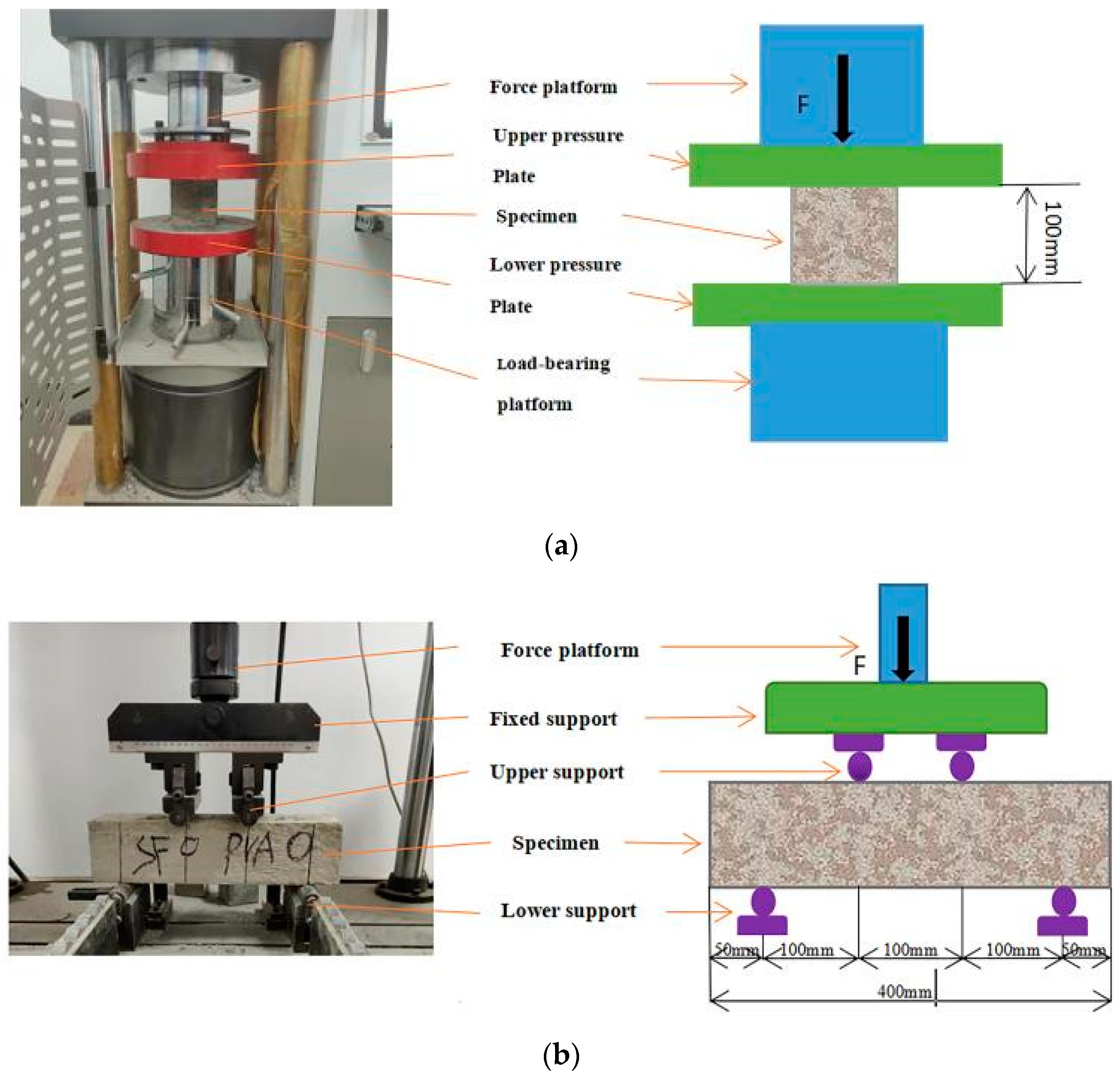
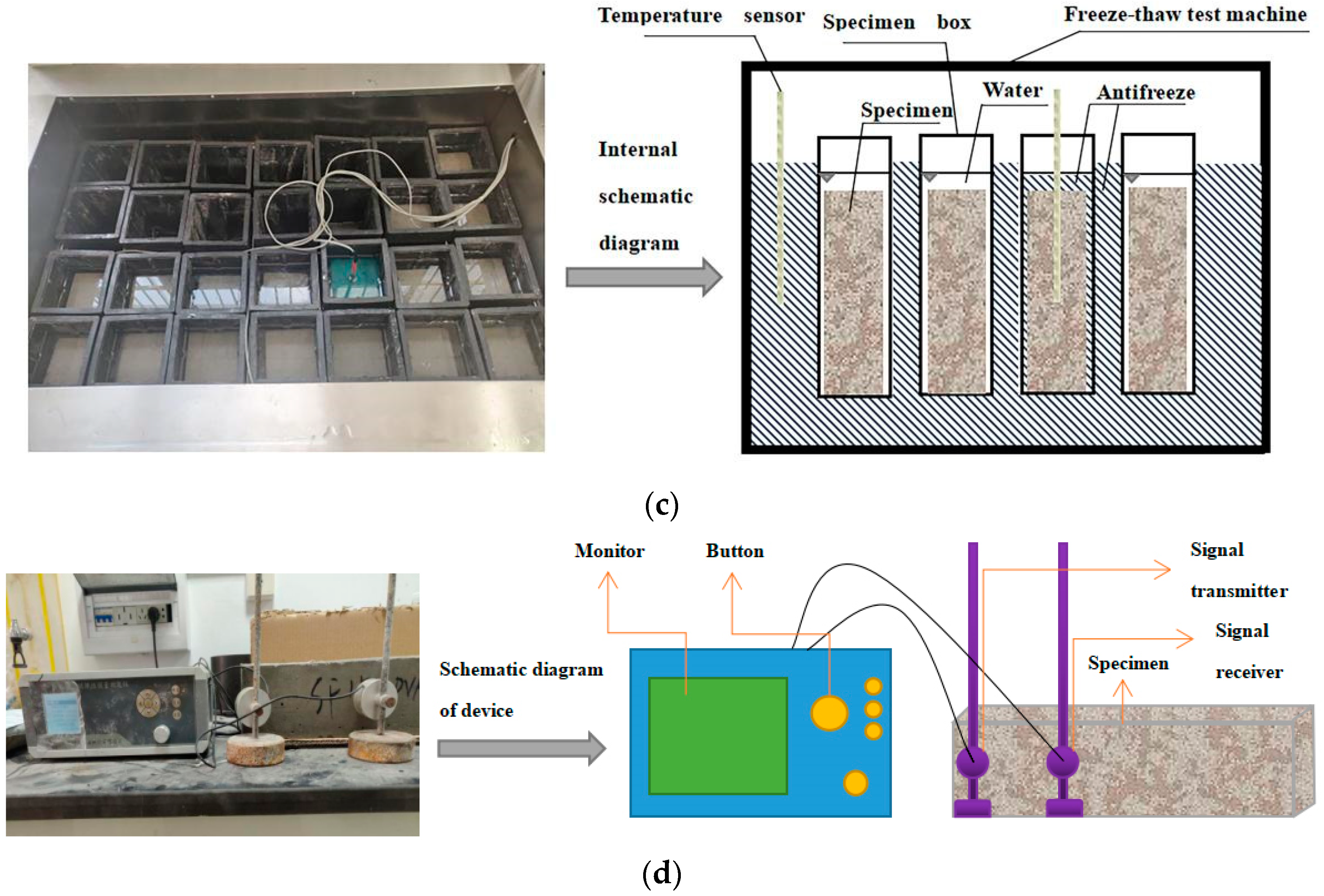

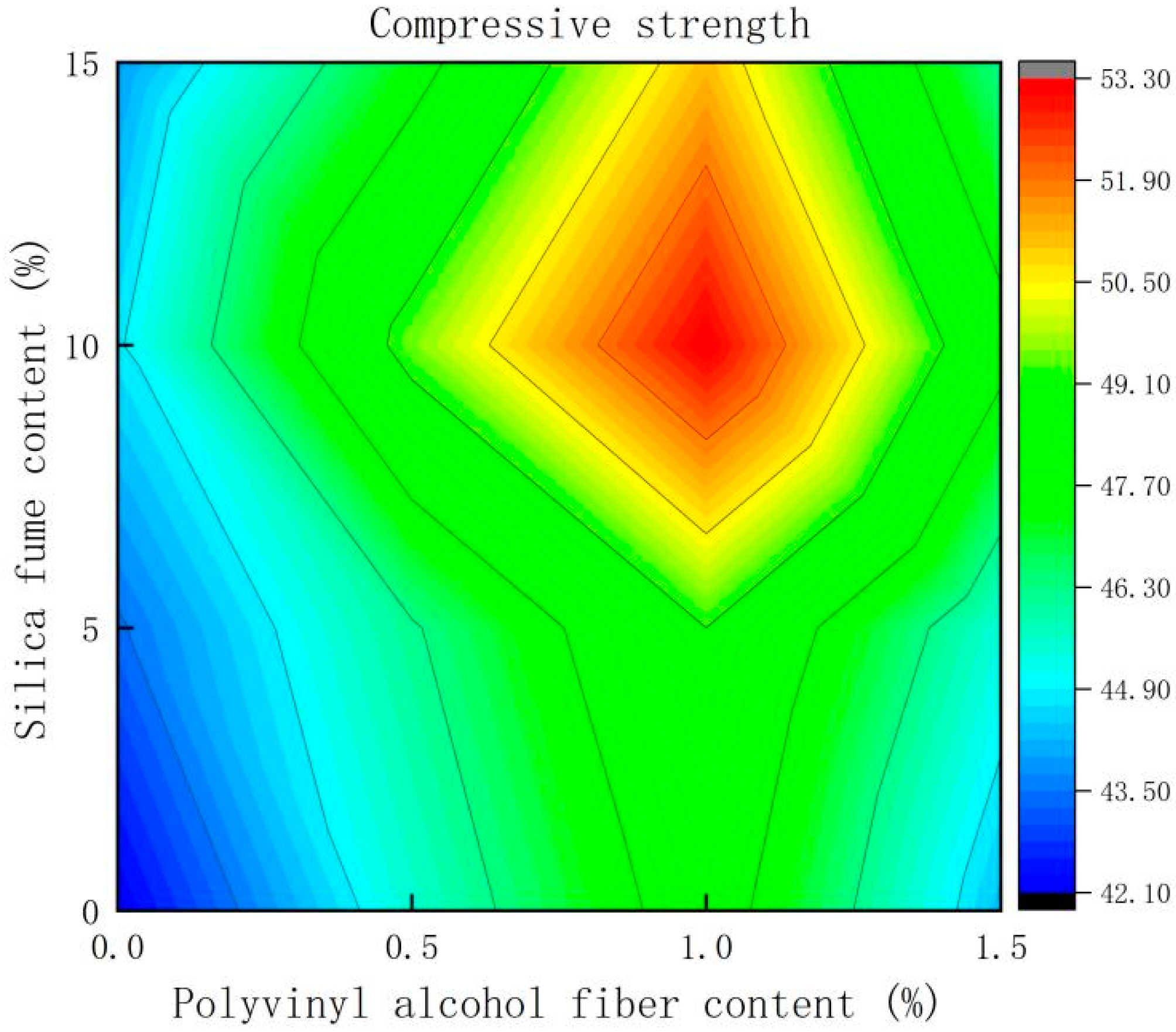

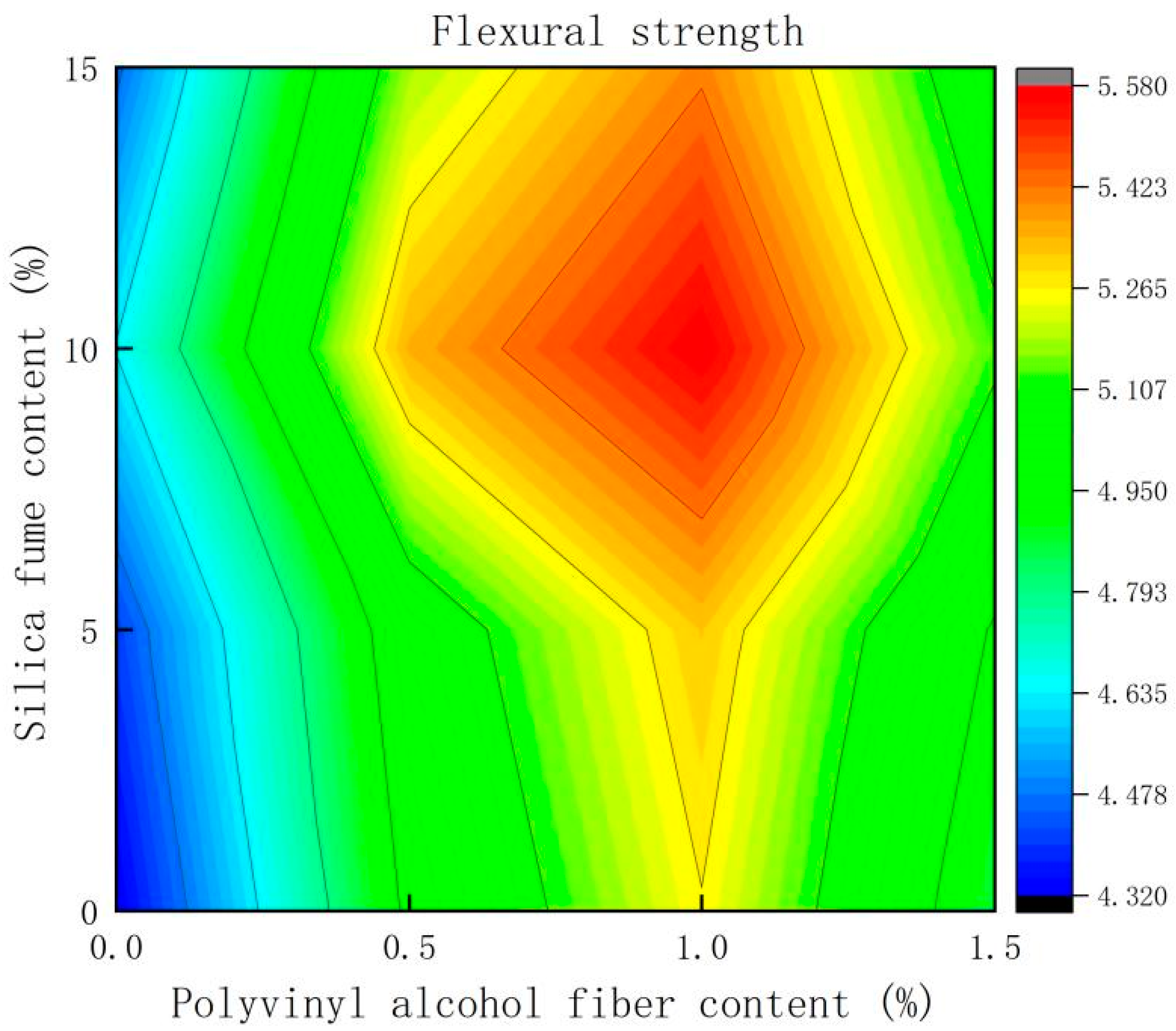
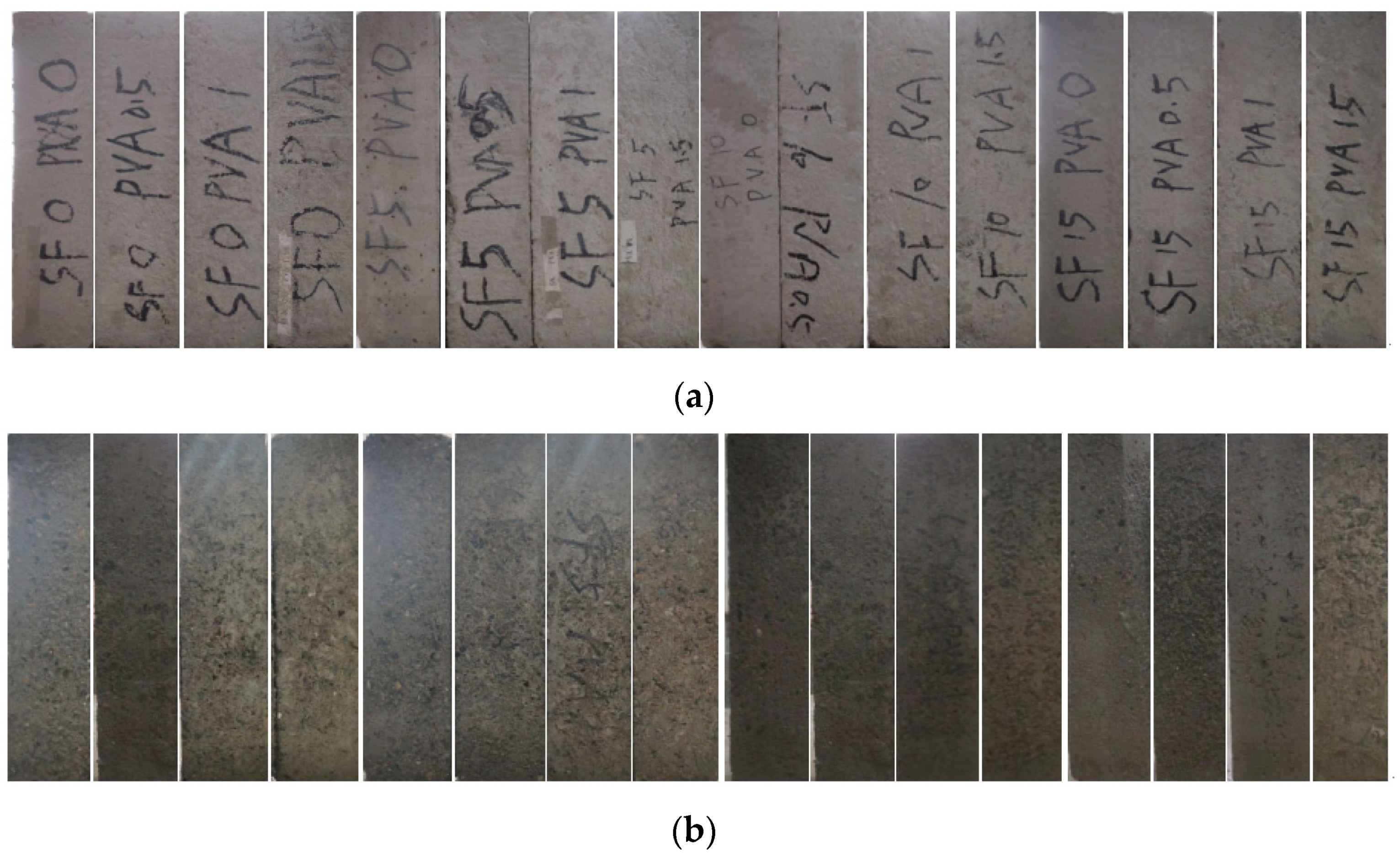
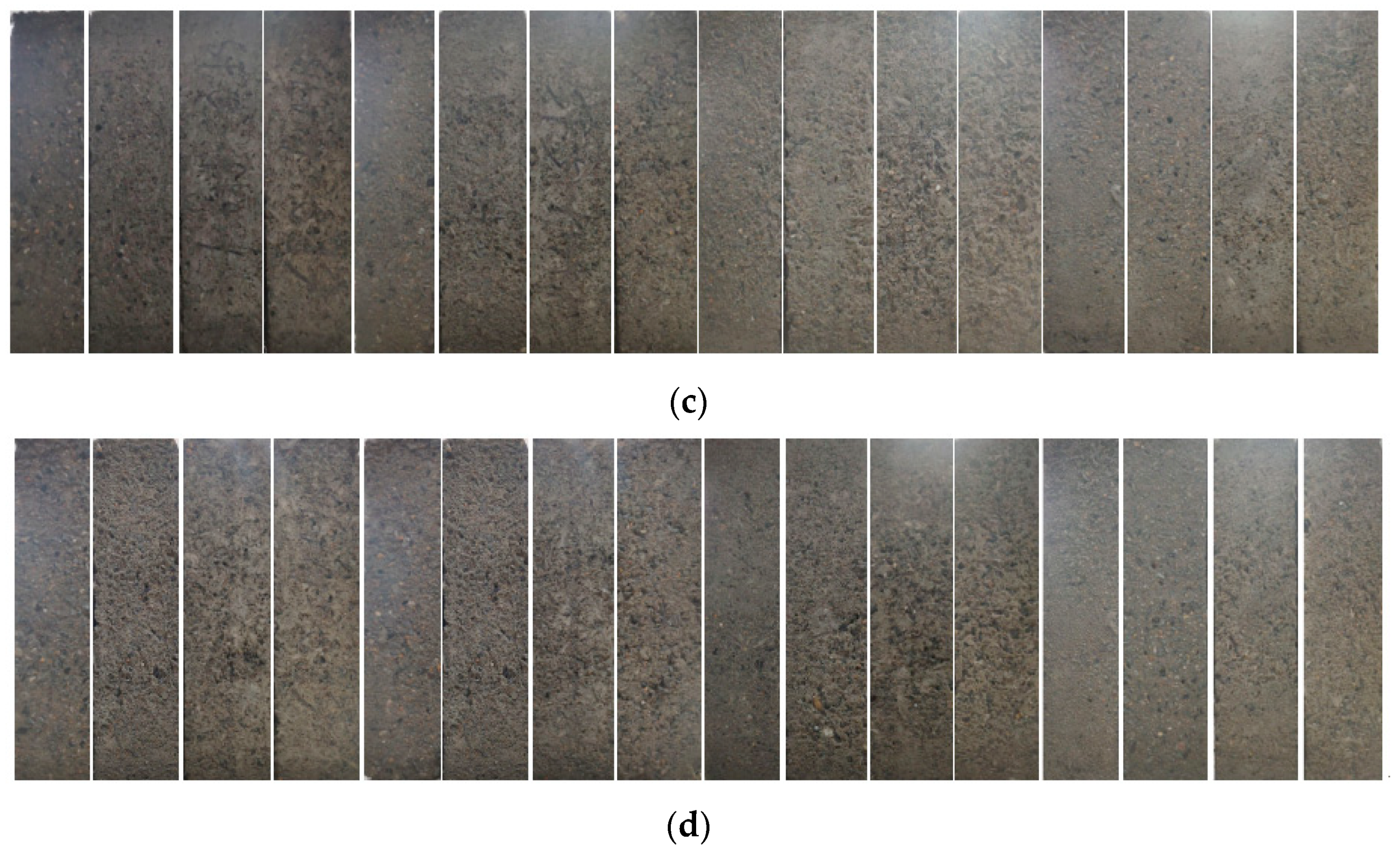
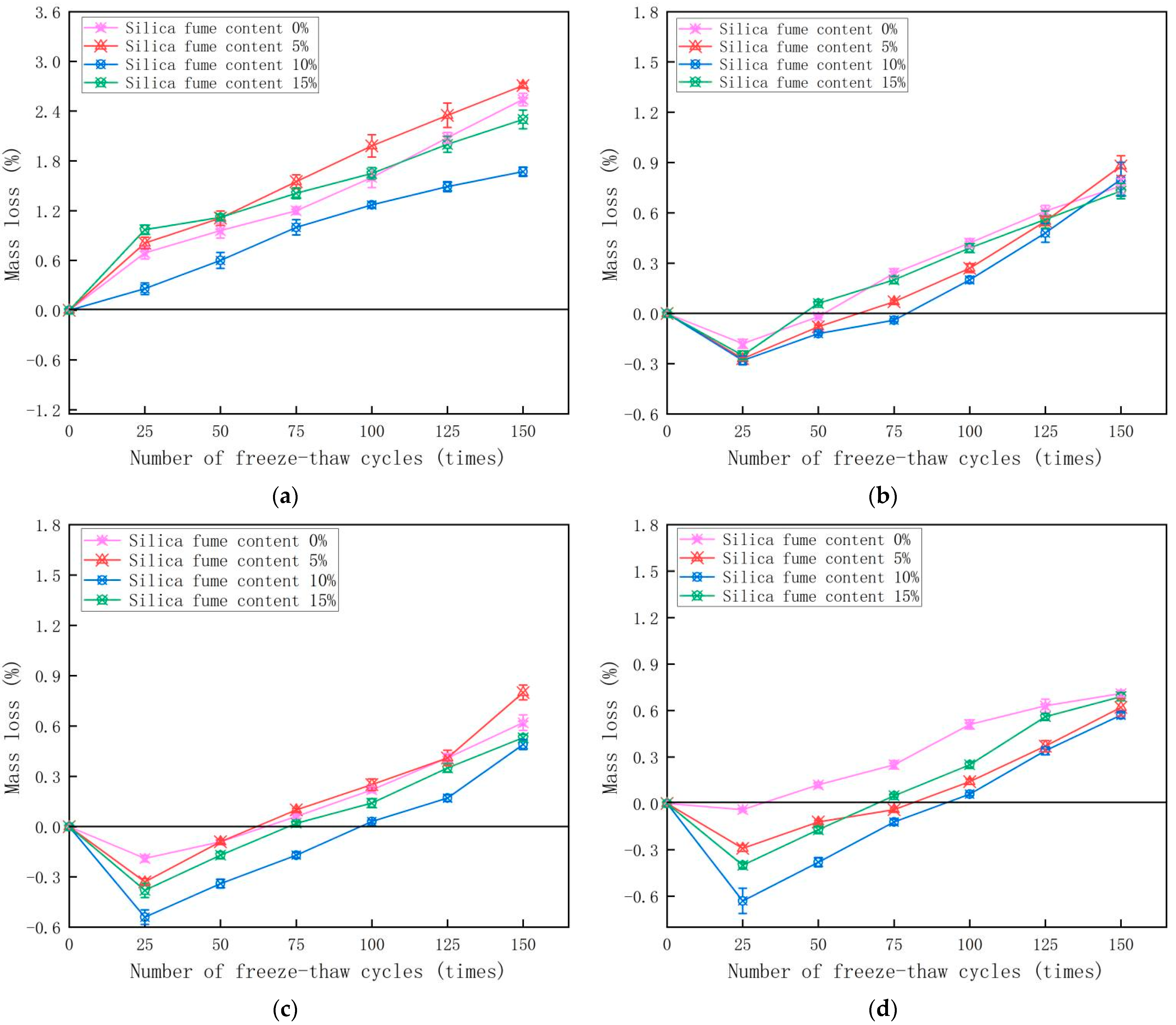

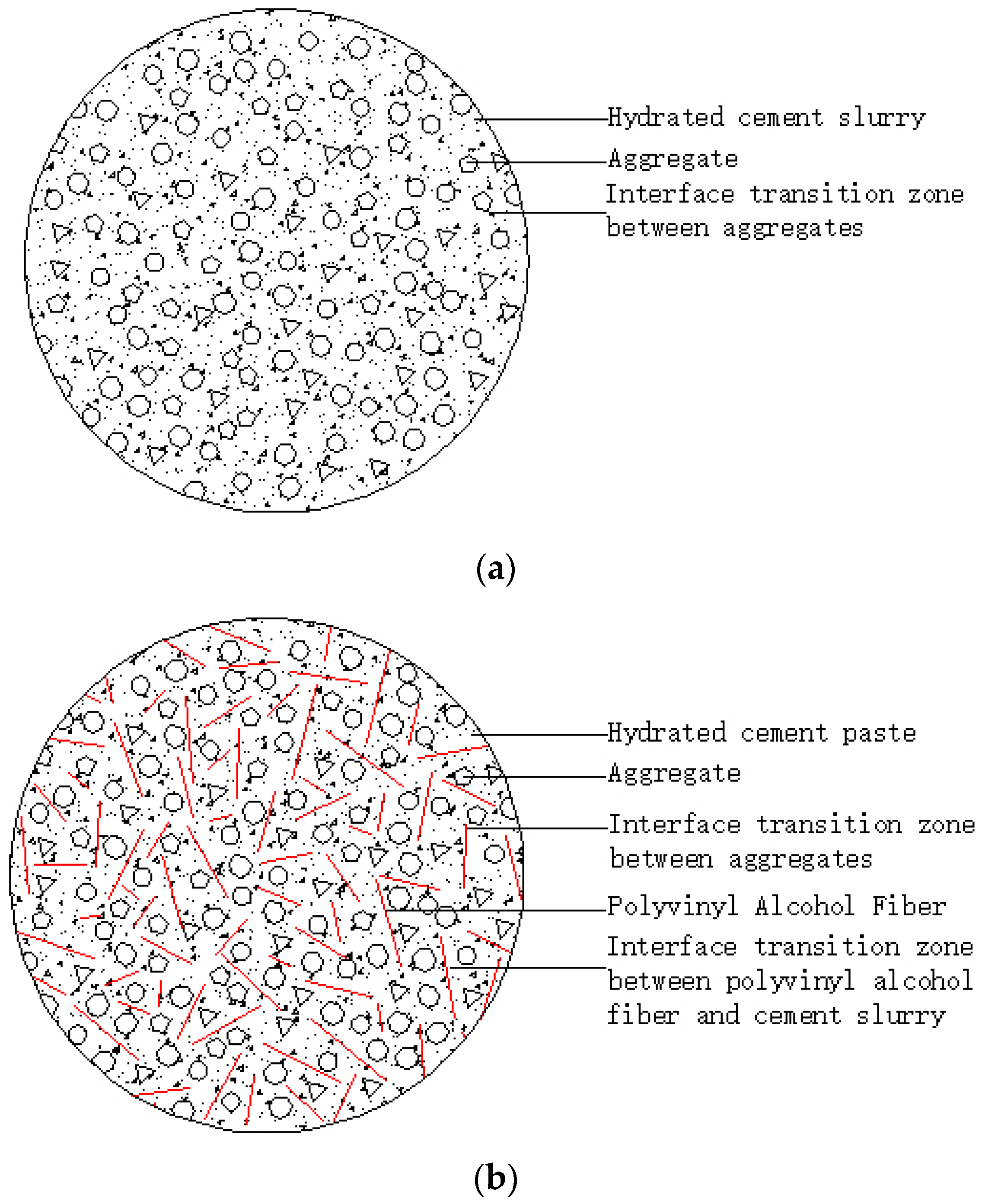
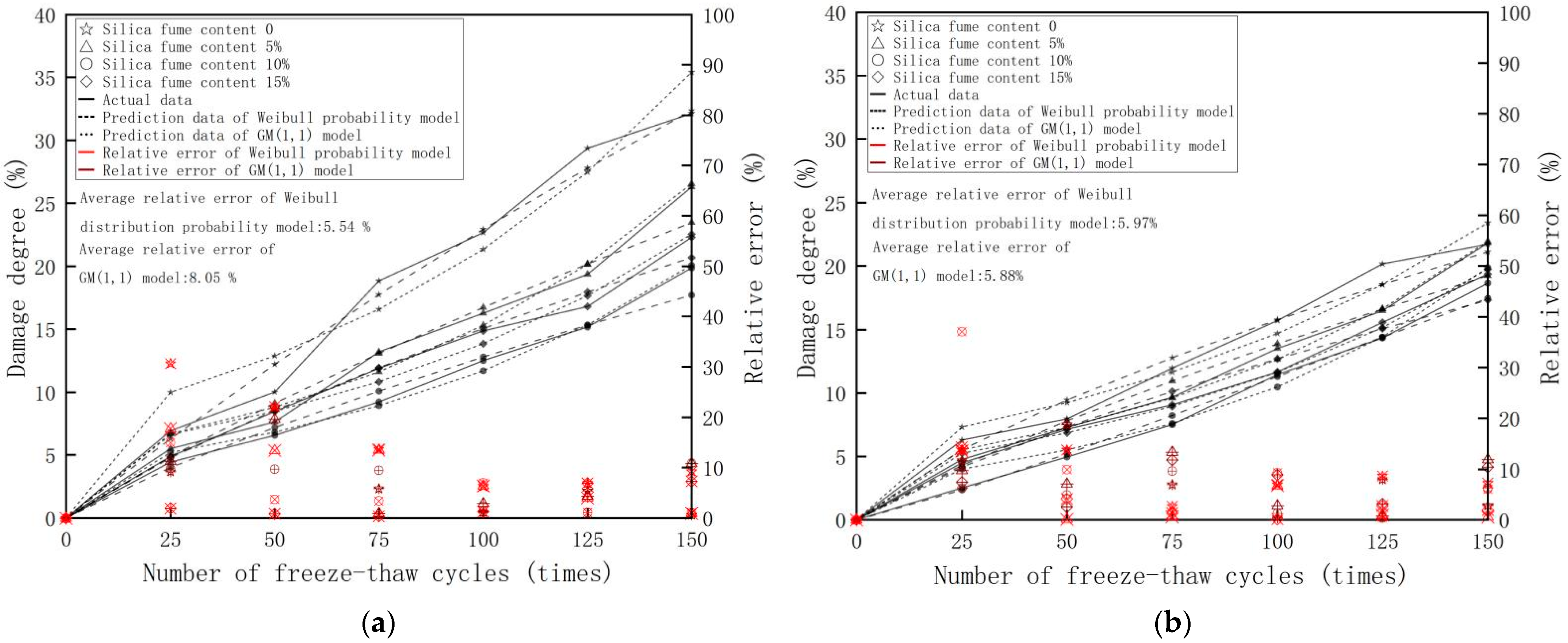
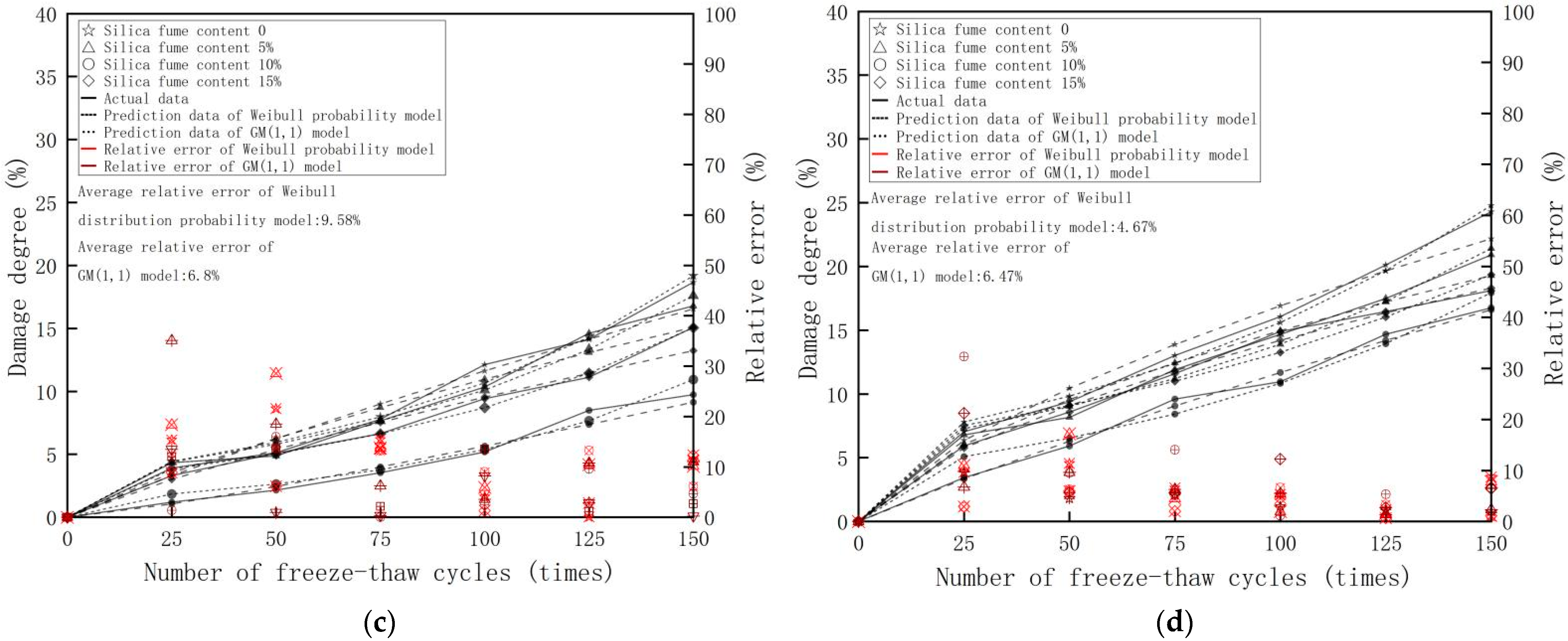
| Material | Information |
|---|---|
| Cement | P. O 42.5 grade ordinary silicate cement produced by Wuhan Xinhua Company |
| Stone | Ordinary graded gravel with particle size of 5–25 mm |
| Sand | Grade-II medium sand, continuous gradation, fineness modulus 2.83 |
| Fly Ash | Henan Hengyuan New Materials Co. Ltd., produces Class-I fly ash with a density of 2.55 g/cm3 |
| Silica Fume | The silica fume produced by Henan Yixiang New Materials Co. Ltd., has a percentage SiO2 content of 98.1% and a specific surface area of 21 m2/g |
| Polyvinyl Alcohol Fiber | Polyvinyl alcohol fiber produced by Kuraray Japan, has a length of 9 mm and a density of 1.3 g/cm3 |
| Water Reducing Agent | Polycarboxylic acid high-performance water reducing agent (powder) |
| Water | Ordinary tap water |
| No. | PVA Volume Ratio/% | Amount of Material/(kg·m−3) | ||||||
|---|---|---|---|---|---|---|---|---|
| Silica Fume | Cement | Stone | Sand | Fly Ash | Water | Water Reducing Agent | ||
| PVA0SF0 | 0% | 0 | 330 | 1061 | 837 | 61 | 170 | 1 |
| PVA0SF5 | 16.5 | 313.5 | 1061 | 837 | 61 | 170 | 1 | |
| PVA0SF10 | 33 | 297 | 1061 | 837 | 61 | 170 | 1 | |
| PVA0SF15 | 49.5 | 280.5 | 1061 | 837 | 61 | 170 | 1 | |
| PVA0.5SF0 | 0.5% | 0 | 330 | 1061 | 837 | 61 | 170 | 1 |
| PVA0.5SF5 | 16.5 | 313.5 | 1061 | 837 | 61 | 170 | 1 | |
| PVA0.5SF10 | 33 | 297 | 1061 | 837 | 61 | 170 | 1 | |
| PVA0.5SF15 | 49.5 | 280.5 | 1061 | 837 | 61 | 170 | 1 | |
| PVA1SF0 | 1% | 0 | 330 | 1061 | 837 | 61 | 170 | 1 |
| PVA1SF5 | 16.5 | 313.5 | 1061 | 837 | 61 | 170 | 1 | |
| PVA1SF10 | 33 | 297 | 1061 | 837 | 61 | 170 | 1 | |
| PVA1SF15 | 49.5 | 280.5 | 1061 | 837 | 61 | 170 | 1 | |
| PVA1.5SF0 | 1.5% | 0 | 330 | 1061 | 837 | 61 | 170 | 1 |
| PVA1.5SF5 | 16.5 | 313.5 | 1061 | 837 | 61 | 170 | 1 | |
| PVA1.5SF10 | 33 | 297 | 1061 | 837 | 61 | 170 | 1 | |
| PVA1.5SF15 | 49.5 | 280.5 | 1061 | 837 | 61 | 170 | 1 | |
| PVA0SF0 | PVA0SF5 | PVA0SF10 | PVA0SF15 |
| y = −0.21997x + 99.35929 | y = −0.16457x + 99.74286 | y = −0.12426x + 99.64643 | y = −0.13877x + 99.09786 |
| PVA0.5SF0 | PVA0.5SF5 | PVA0.5SF10 | PVA0.5SF15 |
| y = −0.14371x + 98.81 | y = −0.13581x + 99.68321 | y = −0.12294x + 100.7321 | y = −0.1224x + 99.42714 |
| PVA1SF0 | PVA1SF5 | PVA1SF10 | PVA1SF15 |
| y = −0.11926x + 100.12286 | y = −0.10916x + 99.81536 | y = −0.06686x + 100.6886 | y = −0.09319x + 99.75179 |
| PVA1.5SF0 | PVA1.5SF5 | PVA1.5SF10 | PVA1.5SF15 |
| y = −0.15099x + 98.48107 | y = −0.12949x + 98.29286 | y = −0.1111x + 99.56821 | y = −0.11671x + 97.95292 |
| No. | a | b | R2 | No. | a | b | R2 |
|---|---|---|---|---|---|---|---|
| PVA0SF0 | −5.95507 | 1.00104 | 0.96547 | PVA1SF0 | −6.42145 | 0.94021 | 0.93195 |
| PVA0SF5 | −6.00477 | 0.93509 | 0.95561 | PVA1SF5 | −6.04931 | 0.84568 | 0.88492 |
| PVA0SF10 | −6.01152 | 0.87357 | 0.96666 | PVA1SF10 | −8.51595 | 1.23158 | 0.96869 |
| PVA0SF15 | −5.80907 | 0.86769 | 0.99007 | PVA1SF15 | −6.24161 | 0.85602 | 0.96131 |
| PVA0.5SF0 | −5.41443 | 0.79316 | 0.94489 | PVA1.5SF0 | −5.1279 | 0.74721 | 0.9574 |
| PVA0.5SF5 | −5.95154 | 0.87967 | 0.96097 | PVA1.5SF5 | −4.99534 | 0.68933 | 0.93931 |
| PVA0.5SF10 | −7.47618 | 1.16286 | 0.99115 | PVA1.5SF10 | −6.38866 | 0.93462 | 0.99056 |
| PVA0.5SF15 | −5.8425 | 0.83496 | 0.96413 | PVA1.5SF15 | −5.0325 | 0.68529 | 0.99056 |
| PVA0SF0 | PVA0SF5 | PVA0SF10 | PVA0SF15 |
| PVA0.5SF0 | PVA0.5SF5 | PVA0.5SF10 | PVA0.5SF15 |
| PVA1SF0 | PVA1SF5 | PVA1SF10 | PVA1SF15 |
| PVA1.5SF0 | PVA1.5SF5 | PVA1.5SF10 | PVA1.5SF15 |
| No. | PVA0SF0 | PVA0SF5 | PVA0SF10 | PVA0SF15 |
| GM (1, 1) model | ||||
| −0.253 | −0.2758 | −0.2704 | −0.2446 | |
| 8.7803 | 5.806 | 4.5249 | 5.8593 | |
| No. | PVA0.5SF0 | PVA0.5SF5 | PVA0.5SF10 | PVA0.5SF15 |
| GM (1, 1) model | ||||
| −0.2328 | −0.2754 | −0.3201 | −0.2643 | |
| 6.4901 | 4.8071 | 3.3993 | 4.5995 | |
| No. | PVA1SF0 | PVA1SF5 | PVA1SF10 | PVA1SF15 |
| GM (1, 1) model | ||||
| −0.293 | −0.2778 | −0.3555 | −0.274 | |
| 3.814 | 3.808 | 1.5402 | 3.3253 | |
| No. | PVA1.5SF0 | PVA1.5SF5 | PVA1.5SF10 | PVA1.5SF15 |
| GM (1, 1) model | ||||
| −0.2313 | −0.2157 | −0.2521 | −0.1888 | |
| 6.9278 | 6.5228 | 4.471 | 6.8423 |
Publisher’s Note: MDPI stays neutral with regard to jurisdictional claims in published maps and institutional affiliations. |
© 2022 by the authors. Licensee MDPI, Basel, Switzerland. This article is an open access article distributed under the terms and conditions of the Creative Commons Attribution (CC BY) license (https://creativecommons.org/licenses/by/4.0/).
Share and Cite
Tan, Y.; Xu, Z.; Liu, Z.; Jiang, J. Effect of Silica Fume and Polyvinyl Alcohol Fiber on Mechanical Properties and Frost Resistance of Concrete. Buildings 2022, 12, 47. https://doi.org/10.3390/buildings12010047
Tan Y, Xu Z, Liu Z, Jiang J. Effect of Silica Fume and Polyvinyl Alcohol Fiber on Mechanical Properties and Frost Resistance of Concrete. Buildings. 2022; 12(1):47. https://doi.org/10.3390/buildings12010047
Chicago/Turabian StyleTan, Yan, Ziling Xu, Zeli Liu, and Jiuhong Jiang. 2022. "Effect of Silica Fume and Polyvinyl Alcohol Fiber on Mechanical Properties and Frost Resistance of Concrete" Buildings 12, no. 1: 47. https://doi.org/10.3390/buildings12010047
APA StyleTan, Y., Xu, Z., Liu, Z., & Jiang, J. (2022). Effect of Silica Fume and Polyvinyl Alcohol Fiber on Mechanical Properties and Frost Resistance of Concrete. Buildings, 12(1), 47. https://doi.org/10.3390/buildings12010047





